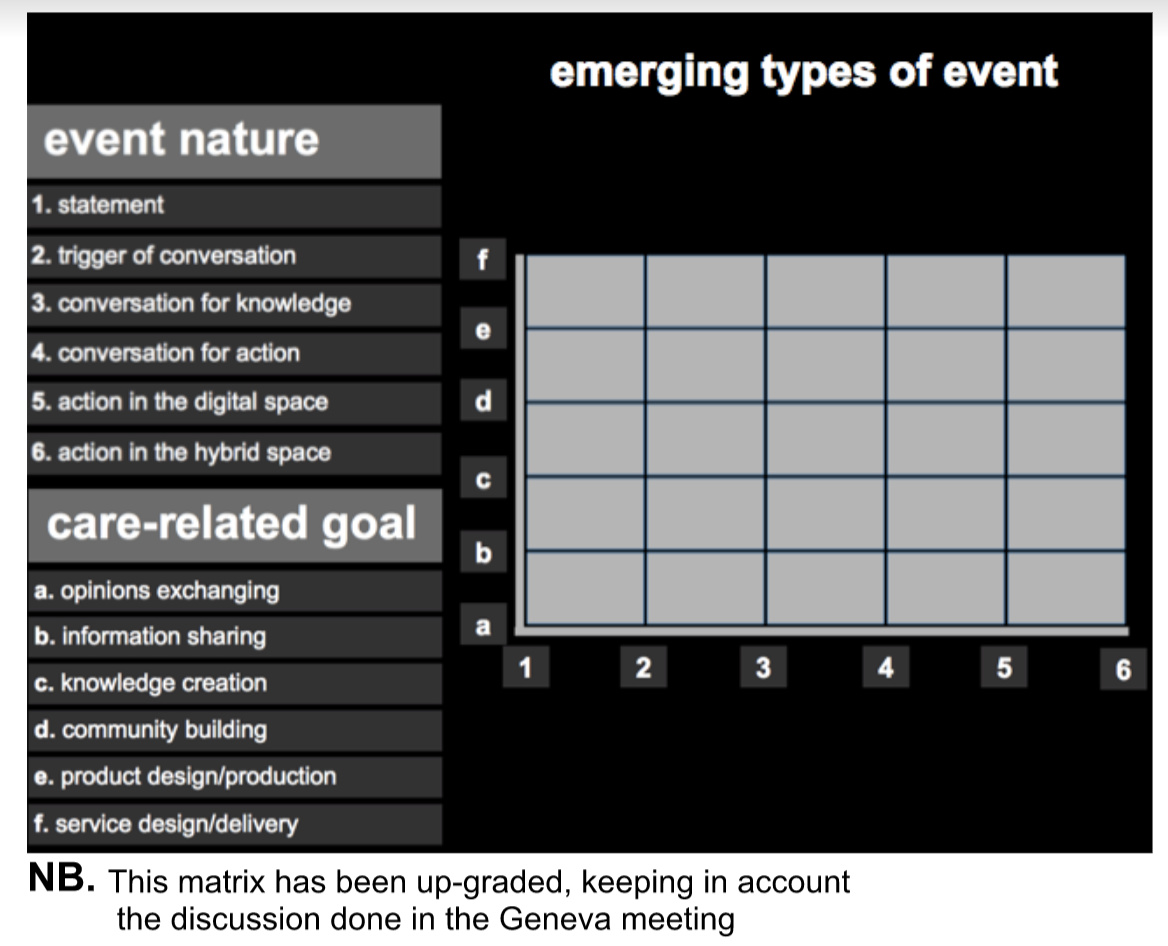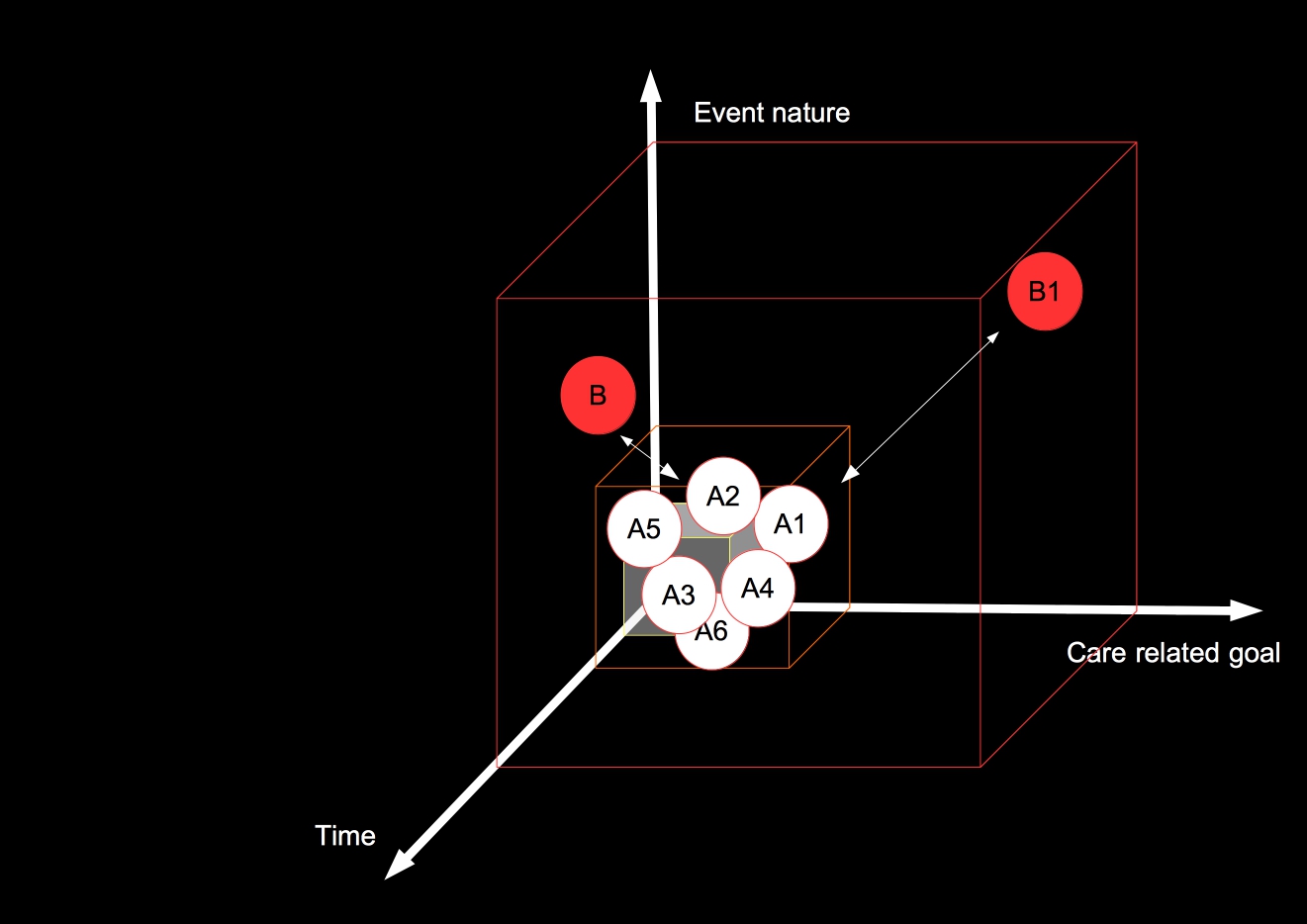Glossary ( a proposal … )
Open Care Glossary
Ezio Manzini Draft 1 (non revised text) 18.03.2017
The following definitions are specifically proposed for the OpenCare community.
They are conceived as tools for the internal discussion and for giving coherence to the different research teams activities and results.
They are divided in two groups:
- First group / words for the different events discussion and evaluation. They are an up-dated version of the ones proposed in my presentation, the 14 March, in Geneva. They could also indicate the parameters for the events discussion in the proposed matrix (see below the up-dated version).
- Second group / words for the research development. They have been used, but not really discussed, in the 14 March meeting in Geneva. They could also be used for the next phase of the research development.
All the word definitions are tailored on the OpenCare specific characteristics. They are based on both normal language and concepts taken from different research fields, as: language-action theory*, actor-network theory**, ecology of infrastructure***(see below some selected bibiliography)
First group / words for the events discussion
Event: something that happens in the OpenCare digital environment. It can include: statements, conversations, actions (i.e. the digital component of actions).
Digital environment: the OpenCare digital space where online events (as, conversations and actions) take place. Depending on its embedded affordances, these events can be, in different ways, supported, oriented or hindered.
Conversation: a sequence of interactions taking place in the OpenCare digital environment. It is related to a given matter of concern. Its interactions are asynchrony and done in a written form. Therefore they are traceable.
Action: a coordinated sequence of interactions aiming at changing the state of things inside and/or outside the digital environment. In our research we directly consider and evaluate the ones happening inside the digital environment. But we are interested to register also the one happening outside it, which can be:
(here there should be the “Emerging types of evetns” matrix - but the system doesn’t up-load it) NB. This matrix has been upgraded, keeping in account the discussion done in the Geneva meeting
Event nature: the inherent features, character, or qualities of an event. It describes the event structure, independently from its specific contents.
1. Statement: information given to make something public, without the specific intention of starting a new conversation, and/or taking part in an existing one.
2. Trigger of conversation: information given with the specific intention of starting a new conversation, and/or vitalizing an existing one.
3. Conversation for knowledge: a sequence of interactions related to a given matter of concern aiming at better understanding it.
4. Conversation for action: a sequence of interactions related to a given matter of concern, aiming at changing the state of things.
5. Action in the digital space: a coordinated sequence of interactions capable to change the state of things inside the digital environment.
6. Action in the hybrid space: a coordinated sequence of interactions capable to change the state of things outside the digital environment.
Care-related goals: the aim of the event for what care-related issue are concerned.
a. Opinions exchanging: expressions of care-related ideas, opinions, feelings
b. Information sharing: exchange of care-related information and experiences potentially useful for care-related actions.
c. Knowledge creating: actions aiming at producing original care-related knowledge.
d. Community building: actions aiming at creating opportunities for meaningful care-related encounters.
e. Product designing/realizing: actions to collaboratively conceive and realize care-related products.
f. Service designing/delivering: actions to collaboratively conceive and realize care-related products.
…………………………………………………………………………
Second group / words for the research development
Matter of concern: topic capable to gather and assemble a variety of human and nonhuman agents.
Socio-material assembly: the gathering and assembling a variety of human and nonhuman agents dealing with a matter of concern.
Socio-material ecosystem: the technical and social environment where conversations and actions take place.
Affordance (of a digital space): a quality or property of a digital space that, by defining and making clear its possibilities, limits and rules, support, orient or hinder online conversations and actions. It depends on the way that digital space has been infrastructured.
Infrastructure: a large scale socio-material assembly that affords local practices, in our case, conversations and actions. Each infrastructure has two components: the operational (physical) infrastructure, and the relational (socio-cultural) one.
Infrastructuring: the action of improving large scale socio-material assembly giving it more effective affordances. Infrastructuring requires long term commitment and results from different kinds of design initiatives: operational infrastructure must be directly design and realized, the relational one emerge from adding up the effects of several local practices ( in our case conversations and actions).
References:
* Language-action perspective
** Actor-network theory
- Bruno Latour and Peter Weibel Making things public: atmospheres of democracy. (Cambridge, Massachusetts Karlsruhe, Germany: MIT Press ZKM/Center for Art and Media in Karlsruhe, 2005).
- Bruno Latour, Reassembling the social: an introduction to actor-network-theory. (Oxford New York: Oxford University Press, 2005).
*** Ecology of infrastructure
- Susan Leigh Star and Karen Ruhleder, Steps toward an Ecology of Infrastructure: Design and Access for Large Information Spaces (1995), Information Systems Research, Special issue on Organizational Transformation, edited by JoAnne Yates and John VanMaanen
- E. Bjorgvinsson, Pelle Ehn, Per Anders Hillgren, PA., Participatory design and democratizing innovation, PDC‟10, 29-NOV-2010, Sydney, Australia
 (So more like option 1a and option 1b here)
(So more like option 1a and option 1b here)
